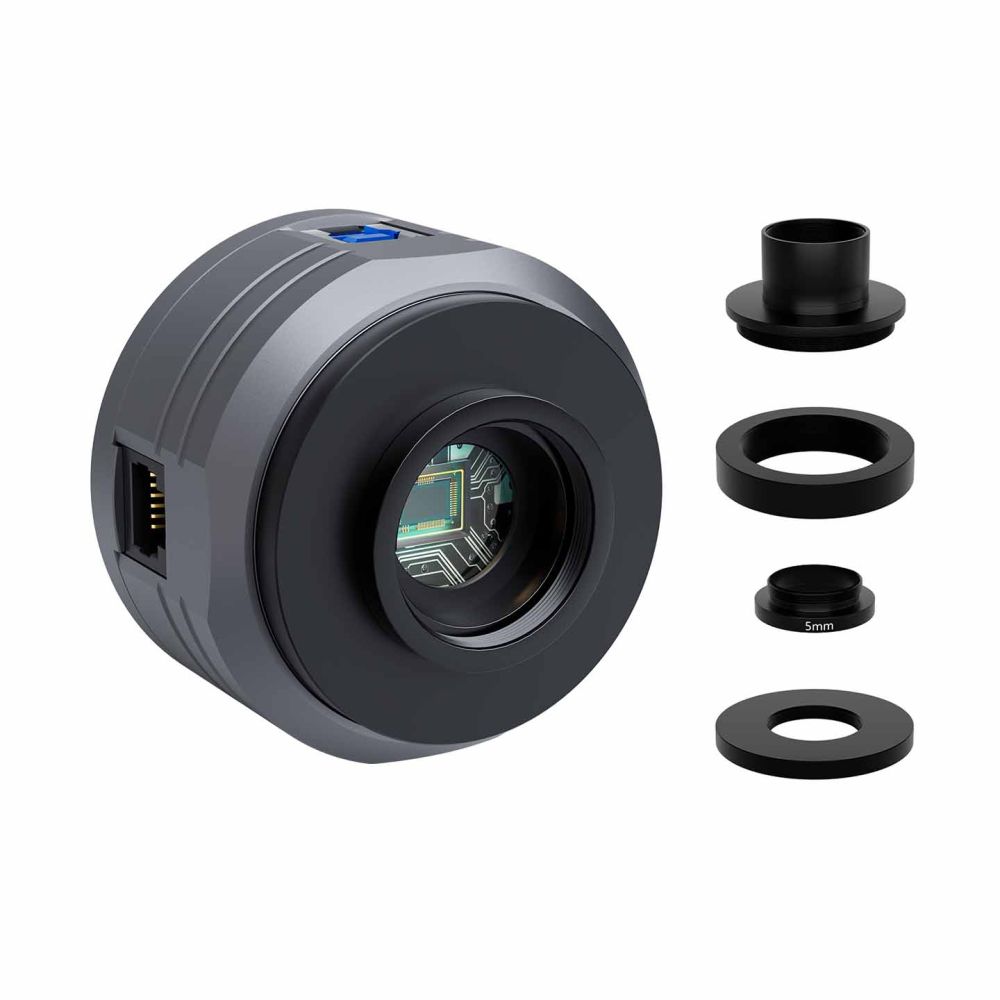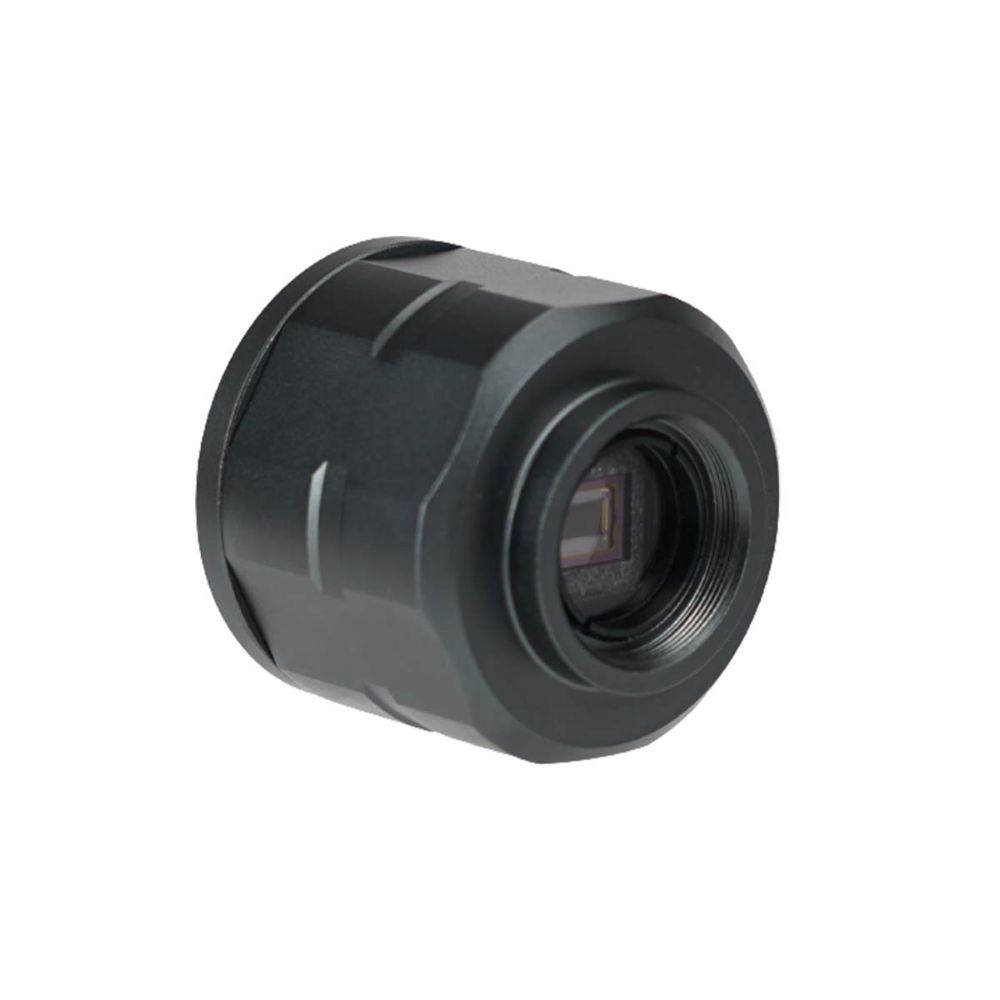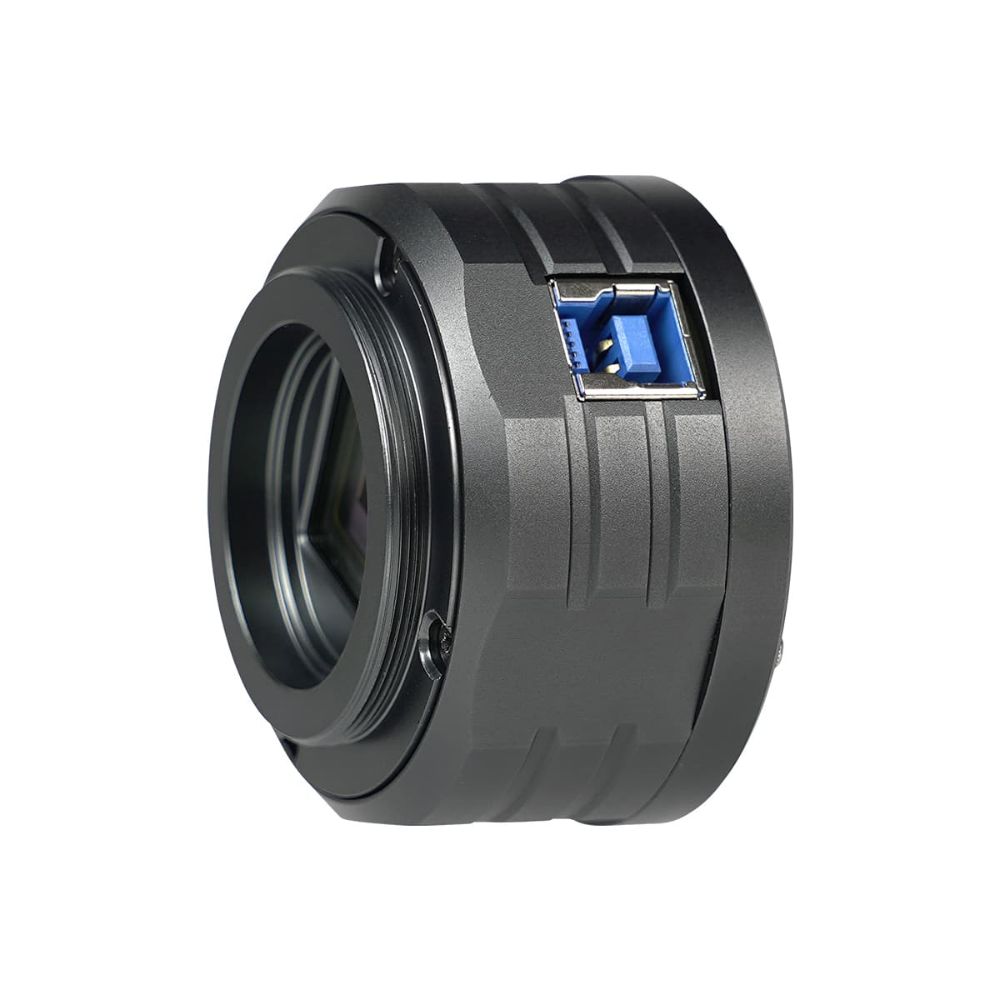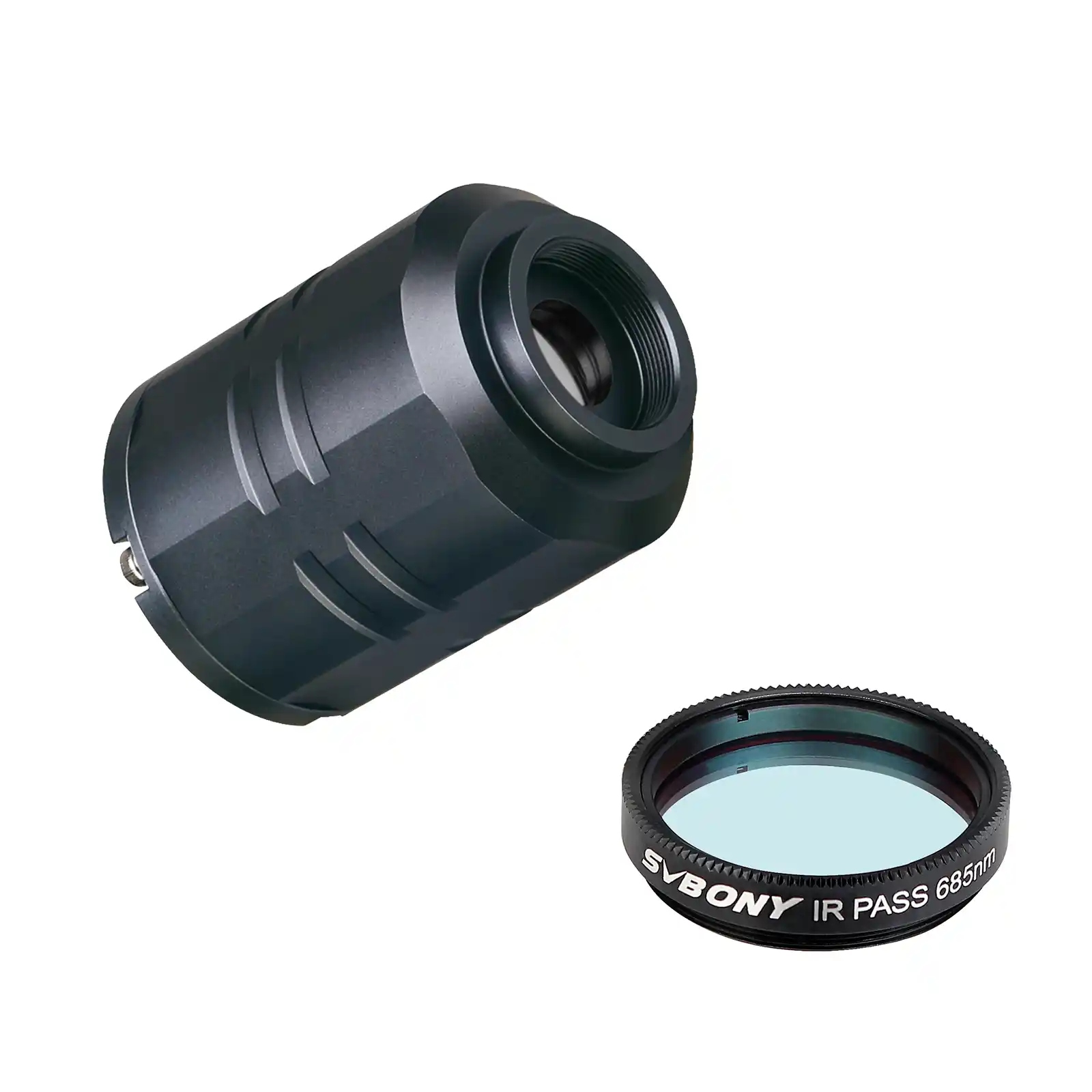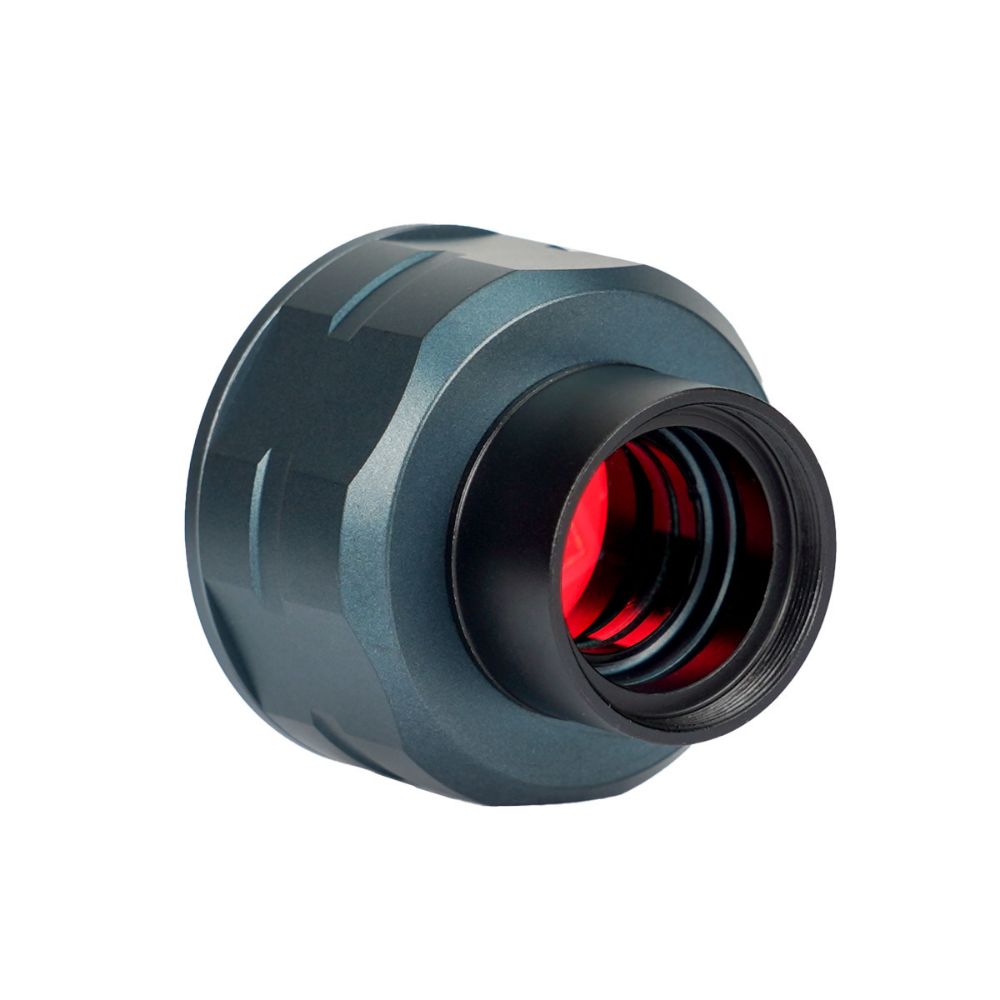Planetary Camera
SC715C
- IMX715 sensor; 1/2.8-inch Format, 1.45μm x 1.45μm pxel size, supports up to 8 million pixels, enabling it to capture extremely detailed image information. It offers higher dynamic range and lower noise, ensuring high-quality and detailed images even in low-light conditions, meeting the needs of professional astrophotography; effectively reduces star trailing or blur during long exposures, ensuring that no details are lost;
- STARVIS II technology; the SC715C osc camera employs advanced image processing algorithms, resulting in higher sensitivity and lower noise levels;
- USB 3.0 Port & ST4 Guide; the SC715C astronomy camera supports data transmission at 45.5 frames per second at full resolution; the cmos camera IMX715 can also connect to an equatorial mount to adjust its position in real-time, preventing shake caused by positional drift and ensuring clear, detailed images;
- 512MB DDR3 cache; allowing the osc camera to respond quickly to every command, reducing delay during focusing and zooming. It ensures smooth, seamless shooting, making it easy for you to effortlessly capture every brilliant moment;
- C/CS-mount eyepiece solution; suitable for different installation needs.
New Release!
SV305C
- SV305C telescope camera adopts the latest IMX662 1/2.8” back-illuminated sensor. Ultra-high sensitivity and ultra-low readout noise, it has better performance in planetary photography and lunar surface photography, and is very suitable for EAA;
- One-key quick setting: high-speed mode and deep space long exposure mode in the sharpcap software, users can choose according to their actual shooting needs, and realize one-key quick setting. It can be saved for convenient one-key setting next time. The unique one-button operation mode makes planet shooting easier;
- UV/IR CUT protective glass with detachable design: If users want to shoot infrared or ultraviolet bands, they can remove the protective glass at the front of the camera by themselves, connect it with a 1.25-inch extension tube, and connect an external IR685, IR850 or UV Venus filter to achieve different shooting experience;
- Using HCG noise reduction technology, when the gain is increased, the HCG mode will be automatically turned on, which can greatly reduce the readout noise, and at the same time retain the high dynamic range of low gain. When the gain value of SV305C telescope camera is 190, HCG will be turned on automatically.
Top New Year Gift Ideas: Perfect Presents for Everyone!
SV705C
- SV705C telescope camera is not only for planetary imaging, but also super well for EAA (Electronically Assisted Astronomy) and nebula Imaging;
- IMX585 CMOS color sensor; Compared with IMX485, it produces up to 45 fps with super low readout noise. It also increases the sensitivity by approximately 1.7 times compared to IMX485. IMX585 has 3 times the number of full well charges, and has a very high signal-to-noise ratio;
- 1/1.2-inch frame, a pixel size of 2.9μm*2.9μm, a maximum resolution of 8.30 Mega Pixel (3586*2180), an imaging area of 11.2mm×6.3mm, and a diagonal of 12.85mm, which can obtain rich celestial details;
- The near-infrared sensitivity is 1.7 times that of the previous generation; which can greatly improve the near-infrared shooting efficiency and capture more details of celestial objects under the same exposure time;
- Dual-gain HDR; which still retains a very high dynamic range at high gain; about 8 times that of the previous generation; which can greatly reduce the read noise;
- Based on the back-illuminated sensor and advanced pixel technology; the SV705C's full well charge can reach 38ke; the peak QE of SV705C can reach about 90%; you will get the better image quality;
- The front end of the camera is a CS port; and is also equipped with a C-CS adapter ring; which can be used with C-mount lenses and CS-mount lenses to make time-lapse video; with a fisheye wide-angle lens; it can be used for all-day.
SV305M Pro
SV305M Pro Astronomy Camera, 2MP USB3.0 1.25 Inches Monochrome and Guide Camera for Astrophotography
- Get a sharp image; uses an extremely sensitive CMOS monochrome sensor; the IMX290LLR-C; which has very high QE (80%); very low readout noise (1.0-3.2e); pixel size 2.9um; 1944*1096 pixels resolution; 6.46mm diagonal;
- Has a stable transmission; built-in 128MB DDRII image buffer; cache the image and transfer it to the computer when the USB interface is not busy or being interrupted; get a sound frame; allows a slower computer with USB 3.0; to capture every frame ;
- Improve camera sensitivity; has ROI and BIN functions; any resolution can be set; could read a smaller region of interest (ROI) out from the sensor; leaving the image scale of the object being imaged unchanged; greatly increase the camera rate; BIN2*2 pixel can merge two adjacent pixels; which can improve camera sensitivity;
- Can automatically guide; designed with ST4 guiding port; supported by PHD2 and the ASCOM platform; use the computer to control the telescope; has an auto-guiding port; which connects directly to the auto-guider; which usually referred as an ST-4 port; works with analog signals;
- Good transformation performance; using USB3.0 high speed data transmission; quick and efficient for planetary imaging.
SV305 Pro
- ST4 Guiding; SV305 Pro camera is designed with ST4 guiding port, supporting the PHD2 software, and works with ASCOM plate form;
- 1ms to 30min long exposure; Long exposure can reach 30 minutes, you can use it for planetary imaging, lunar imaging and some bright deep space objects imaging;
- Back-illuminated CMOS Sensor; The SV305 Pro uses an extremely sensitive IMX290 CMOS sensor, this sensor has very high QE and very low 0.7e- read noise, which improved sensitivity in the visible-light and near infrared light regions for industrial applications;
- 128MB DDR Buffer; This buffer also allows a slower computer with USB 3.0 socket to capture every frame without loss even if the USB socket is occasionally busy with other peripherals. This buffer also makes it possible to run multiple cameras using one computer without USB transfer problems;
- Any Area ROI Support; A smaller region of interest ROI is read out from the sensor, leaving the image scale of the object being imaged unchanged. Allow arbitrary resolutions to be set.
SV105
- The SV105 electronic telescope eyepiece is the basic method for starting astronomical imaging; you can use the SV105 electronic telescope eyepiece to image it; which is more suitable for beginners who like to do astrophotography;
- SV105 telescope camera is suitable for lunar and planetary photography; share the view of bright planets; moon and terrestrial targets; just point the telescope at the moon or planet and record a quick video; you can transfer the real-time view of the telescope to your laptop or PC. Dark light compensation technology; greatly improve the camera's image clarity in low light conditions; no pixel vignetting;
- Plug and play; no driver required; real-time dynamic observation; clear images; SV105 electronic telescope eyepiece compatible with Windows system needs to download Sharpcap Capture; Linux system needs to download AstroDMx Capture; Android system needs to download USB Camera;
- The image processor adopts dark light compensation technology; SV105 electronic telescope eyepiece can greatly improve the image clarity of the astronomy camera under low light conditions;
- Interesting and useful USB eyepiece camera; standard 1.25 inches; threaded M28.5x0.6; can be used with telescope filters; directly connected to the telescope;
- The SV105 electronic camera uses a 1/2.8" IMX307 imaging sensor; up to 30 frames per second at 1920*1080 resolution; can record 2K video at high speed.
SV505C
- At full resolution, the camera frame rate of SV505C can reach 93fps, and more frames can be captured at the same time. Especially in the case of bad weather, the shooting can be completed quickly by using the shooting gap time;
- SV505C has a QE of about 80%. It has extremely high sensitivity in the near-infrared region and extremely high signal-to-noise ratio in the dark environment. It is very suitable for photographing the surface details of Mars, Jupiter, Saturn and other solar system planets and the moon. The camera has extraordinary sensitivity in the infrared band;
- The SV505C has a 1 / 1.8 "frame, and the chip area is 7.9mm * 4.5mm, which means that the photosensitive area is almost twice that of the sv305 pro. With the same telescope, a larger area can be photographed.
SV205
- Svbony SV205 with SONY IMX415 CMOS sensor and USB3.0 Type-B port. It complies with the standard UVC protocol and no need to install SVBONY driver. It is the plug and play device, suitable for beginner users for astronomy photography;
- The image sensor uses dark light compensation technology to greatly improve the camera's image clarity in low light conditions;
- In MJPG video format;you can record video quickly and the frame rate up to 30FPS at 2K resolution 1920x1080; You can also choose YUV uncompressed video format;
- The camera allows you to capture a real-time video and transport to your laptop or PC;machined aluminum 1.25" adapter barrel for direct threaded connection to almost any telescope.
SV305
- BSI CMOS sensor; SV305 telescope camera uses an extremely sensitive back-illuminated CMOS sensor; IMX290 sensor has very high QE and very low (0.7e-) read noise; which improved sensitivity in the visible-light and near infrared light regions for industrial applications;
- 128MB DDR buffer; the benefit of the image buffer is that the memory will cache the image and transfer it to the computer when the USB interface is not busy or being interrupted; and the frame will not be lost or corrupted;
- Any area ROI support; the SV305 astronomy camera has ROI function; a smaller region of interest (ROI) is read out from the sensor; leaving the image scale of the object being imaged unchanged; allow arbitrary resolutions to be set;
- SV305 planetary camera compatible with Windows system; Linux system; Mac OS system; and Raspberry Pi system; Windows driver 1.3.7 version; support ASCOM driver; PHD2 guiding software; not support Phone system;
- Long exposure can reach 30 minutes; high-speed; medium-speed; low-speed three output frame speeds are optional; matching different computer hardware to achieve a more suitable reception speed of the hardware; meet the basic needs of astronomy enthusiasts for planetary photography.





